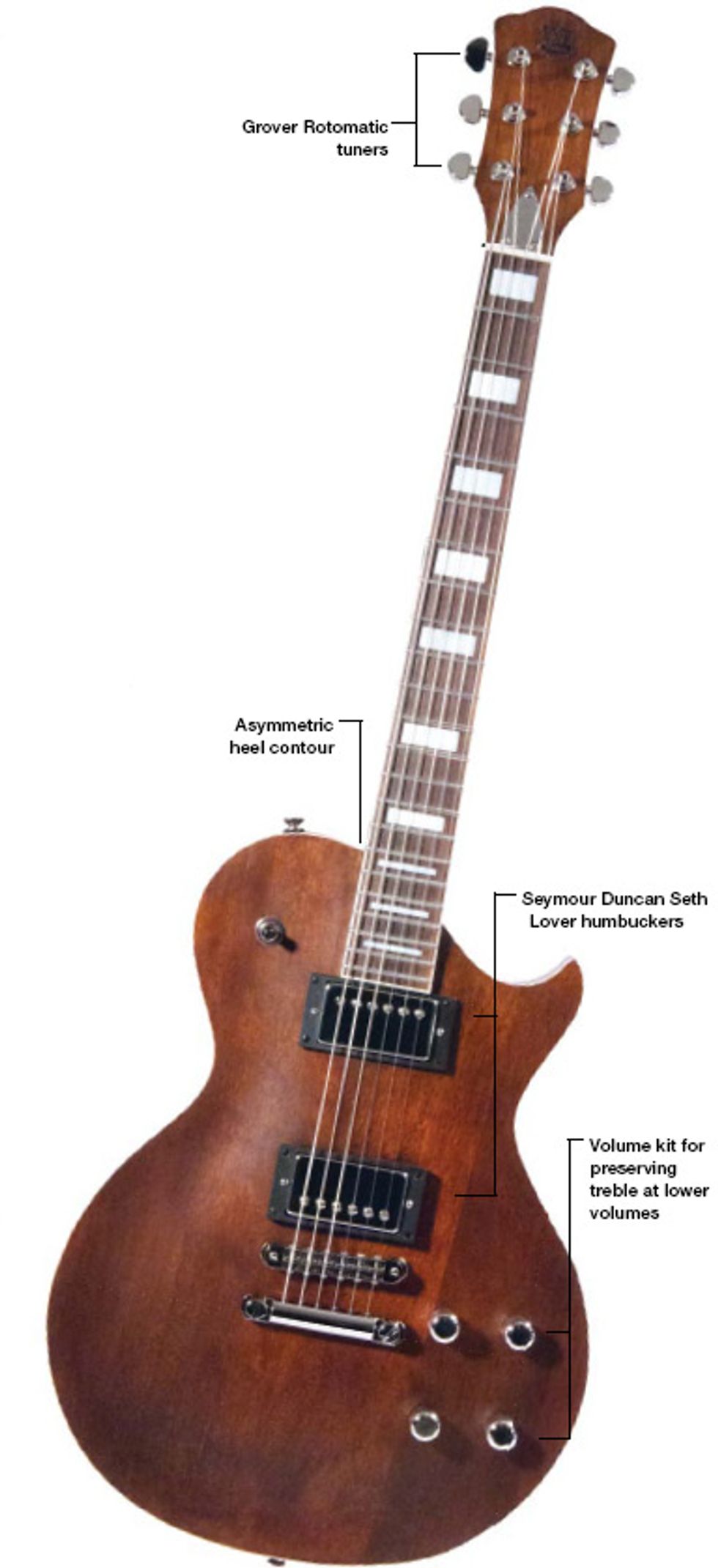Download Example 1 Bridge Pickup Download Example 2 Neck Pickup Clips recorded using Fryette S.A.S. distortion pedal, Fender Pro Junior amp, Planet Waves Custom Pro cables, and Apogee Duet
 | |
| Download Example 1 Bridge Pickup | |
| Download Example 2 Neck Pickup | |
| Clips recorded using Fryette S.A.S. distortion pedal, Fender Pro Junior amp, Planet Waves Custom Pro cables, and Apogee Duet into GarageBand. | |
Junior League
The American Badwater 1216 uses the Les Paul Jr. as a jump-off point and adds a little more personality with some unique shaping around the cutaway and upper bout. It’s built with a mahogany neck set into a mahogany body—about as simple and straightforward as it gets. But it also features some more up-to-date design elements, like an asymmetrically contoured neck heel for better access to the highest frets on the treble side.
Perhaps most beneficially, the 1216 features an electronics package rarely seen on guitars in this price range. The pickups are a pair of Seymour Duncan Seth Lovers. The internal components include CTS pots, Sprague Orange Drop capacitors, and a volume kit that keeps treble frequencies consistent when the volume is rolled off. And everything is connected with vintage-style cloth-covered wire.
The 1216’s hardware is high grade, too. The nut is a Graph Tech Tusq XL, which Graph Tech claims brings out harmonics and richness while improving tuning stability. Tuners are three-per-side Grover Rotomatics, and the TonePros Tune-o-matic–style bridge and tailpiece—parts commonly used as upgrades even on expensive guitars—lend solidity and sustain.
With its walnut finish and minimal adornment—an AXL logo branded into the headstock and rectangular fretboard inlays—the 1216 is a handsome guitar. It is well made, too: The fretwork is tidy and the neck-to-body joint is tight and clean. However, the guitar’s distressed treatment reveals more about the sacrifices you make at this price point: The satin finish looks less like it’s relic’d than sloppy, with irregularities that could’ve been smoothed out in the manufacturing process without sacrificing the aged feel. The white binding on the neck and body is also smudged with brown, which looks more like rushed work than an aesthetic consideration.
From Cutting to Smooth
At 8.68 pounds, our 1216 is light for a mahogany, 24 3/4"-scale Les Paul–style guitar. It’s comfortable to hold and, with its action set low, it’s a joy to play right out of the box. The neck has an agreeable C shape—a bit less hefty than what you’ll encounter on many vintage- Gibson-inspired guitars, and a definite plus in my opinion. Without an amp, the 1216 has a fair amount of sustain, but not quite the resonance you’d associate with the finest Les Pauls.
To test the 1216 I plugged into a Fender Pro Junior amp and, on occasion, a Fryette S.A.S. distortion pedal. Overall, the 1216 sounds appealingly meaty, with lots of midrange punch. The volume kit, as advertised, does help ensure tonal consistency when the knobs are tweaked. But the knobs don’t have the smoothest taper, and one of the knobs on our review model grinded stubbornly against the guitar when turned—a small detail that could turn into a major annoyance at a gig.
Although it certainly wasn’t a fair comparison given the major price difference, for the heck of it I compared the 1216 to a 1960 Gibson Les Paul Historic. The 1216 is, predictably, a tad darker than the Historic. And as you’d expect, the AXL doesn’t sound quite as warm and harmonically complex as the Gibson. To be fair, though, the AXL costs a tiny fraction of the Gibson, and it actually held up pretty well considering its dinky price.
On the bridge pickup, the 1216 bites—without sounding strident—and lends itself well to Mike Bloomfield-style soloing. The neck pickup, meanwhile, sounds thick and spongy. Rolling off the tone, I got a surprisingly reasonable approximation of Slash’s rounder lead tones. In tandem, the pickups seem to holler for some gritty rhythm work and pentatonic riffing, which the guitar delivers with clarity.
While the 1216 sounds most at home in rock and blues settings, it’s a pretty adaptable guitar. It wouldn’t be mistaken for, say, a Gibson L5-CES, but with a clean tone on the neck pickup, it sounds good enough for some Wes Montgomery–style octaves and chord melodies, with good separation between the individual notes. And the neck pickup, with its Tone control around 8 or so, works well for countrified pedal-steel-style bends.
The Verdict
With the Badwater USA 1216, AXL offers a remarkable value in a single-cutaway, humbucker-equipped guitar with appointments typically found on instruments many times its price. While it wouldn’t necessarily be an adequate substitute for a Gibson Custom Shop Les Paul, the 1216—with its excellent playability and versatile sonics—is well-suited to any guitarist who likes to keep things simple and rock. And at a price that’s nearly impossible to beat.
Buy if...
you want a Les Paul-style ax but can’t afford an authentic Gibson, or you need an inexpensive but capable backup.
Skip if...
you’re a Gibson loyalist or can’t tolerate minor finish-work imperfections.
Rating...
MSRP $800 - AXL Guitars - axlguitars.com |

